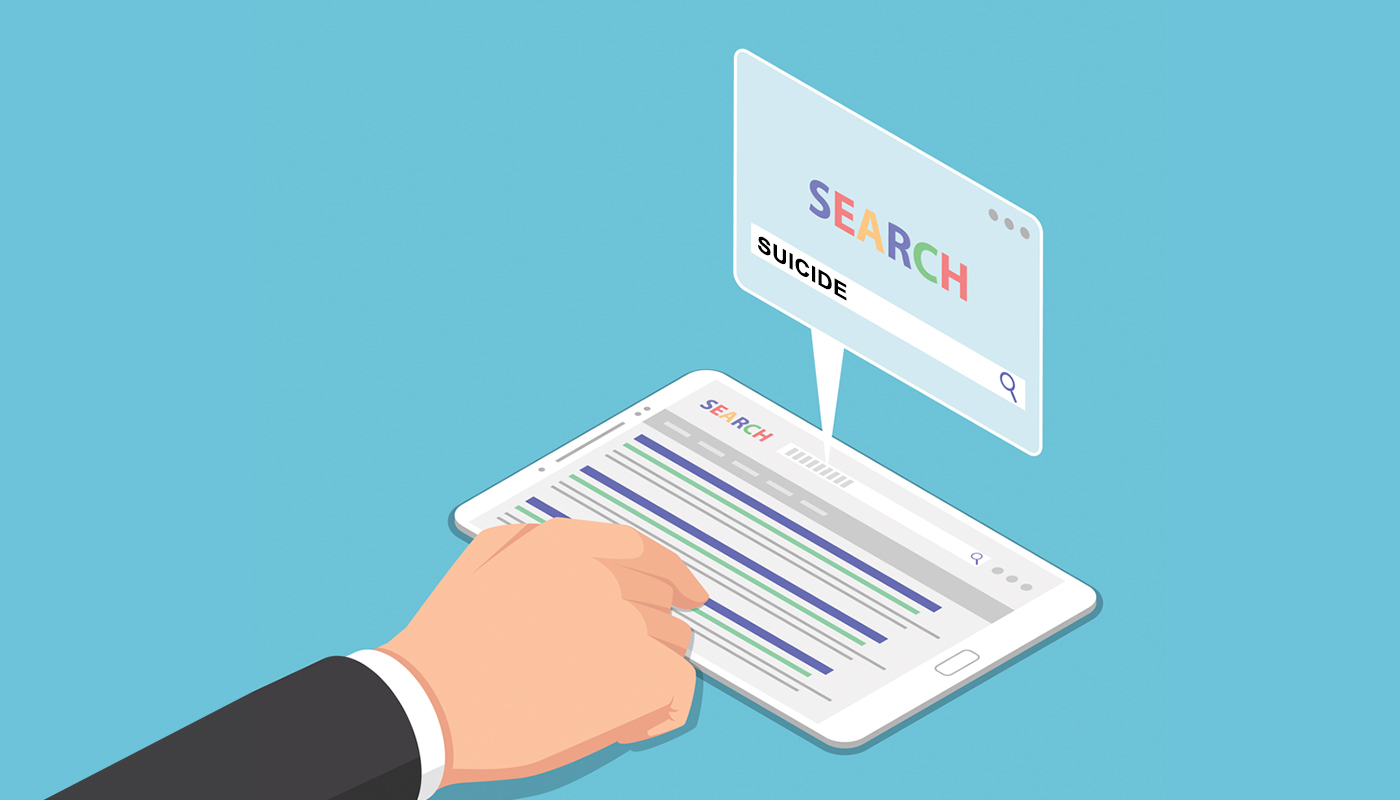Can Smart Search Engines Prevent Suicide?Cheng Qijin reveals online search results can provoke or hamper suicidal thoughts
January 2021

Do online suicide-prevention methods work? The Internet and social media are sometimes cited as aggravating factors in pushing people to suicide, so can online influences be put to good use, too?
Yes, and no. Highlighting online hotlines does no harm, but equally it does little good in redirecting suicidal people, according to the work of Prof. Cheng Qijin. She came to the conclusion that pinning a suicide-prevention service or contact details to the top of the page doesn’t help all that much even if those details are thrown up first in search-engine results using suicide search terms. But the disappointing results do provide hope.
People searching for information about suicide are less likely to proceed, and more likely to seek help, if their online search yields a full page of results about suicide prevention. Professor Cheng came to those conclusions after an analysis of suicide-related searches over a span of 10 months in the US, the UK, Hong Kong and Taiwan.
It appears that suicidal people value the preponderance of information, placing stock in the second, third, fourth link thrown up in a search as much as the first. They are not just searching for suicide-prevention contacts, but value an online world that presents prevention options to them. If the material they see discusses suicide methods in detail, news stories about celebrity or shocking suicides, or even glorifies suicide, they may be more likely to look for pro-suicide information, fuel for suicidal actions.
‘The whole layout of first-page search results is important,’ Professor Cheng explains. ‘There are other methods that may be more useful than a hotline.’
Professor Cheng, who is an assistant professor in the Department of Social Work, won a Young Researcher Award in 2019 for this analysis of suicide-prevention helpline notices, supplied via search engines such as Google and Microsoft Bing. The work was the first attempt to interpret the effectiveness of pinning suicide-prevention hotline information to the top of search results. Professor Cheng teamed with co-author Elad Yom-Tov, who works at Microsoft Research and therefore has access to proprietary Microsoft data. They adapted the results into a paper published in the Journal of Medical Internet Research.
Browser archive history can show what kind of information Internet users continued to seek after seeing hotline information displayed. The pair also bought search-engine archives from Google for the Chrome browser to reconstruct a user’s search history.
‘If people see the hotline and look for more preventative information, it may show that their mindset is changed,’ Professor Cheng says. ‘It’s a proxy.’ A bigger proportion of preventative information on the first search serves as a significant predictor for future search use for additional preventative information over the next week.

Search engines are in a quandary as to how to treat suicide searches. Search engines also do not want to censor findings, since not all people searching for information about suicide are intent on killing themselves, as researchers or reporters covering the topic know only too well.
It is also difficult for search companies to write algorithms specific to suicide, with algorithms normally designed, for good or bad, to make content ‘sticky’ and keep people online. However, there is no doubt from Professor Cheng’s findings that it is harmful to fill a person’s feed with tales of lurid suicides or information on how to kill yourself based on their prior search history. For search companies, their commercial interests and freedom of information need to be balanced with the social good.
The research results suggest search engines and website administrators should use innovative ways to improve the visibility of suicide-prevention information. Certainly, paying to promote suicide-prevention pages can help propel them to more prominent positions in search results. Regulators and authorities may also choose to restrict how some kinds of information are released or promoted.
Professor Cheng specializes in quantitative and qualitative analysis of the role of mass and new media in mental-health issues and suicide prevention. She draws on her prior experience as a journalist in the Beijing bureau of the newspaper Southern Weekly in working with companies such as Facebook, Google and Baidu, which she has helped improve their suicide-prevention strategies, as well as promoting responsible coverage of suicide in the media in Hong Kong, Taiwan and mainland China.
Occasionally, police investigators or family will go through the search history of people who have died by suicide. But that is normally done when there’s a question as to whether the person killed themselves or not. Unfortunately, it’s not an ever-present part of a suicide investigation.
How the media report suicide is also highly influential. Whereas in Hong Kong, deaths by suicide and even the method of death are routinely given prominence, they are played down or not mentioned in other jurisdictions. There is consistent evidence that media coverage of celebrities who kill themselves increases the overall risk of suicide in the general population. Discussion of new methods of suicide also increases the risk.
Charcoal burning was an unheard-of and novel method of death when it was first used by a woman who killed herself in Hong Kong in 1998. The media in Hong Kong covered the death in a very detailed way, even providing fact boxes about the method and how much charcoal is necessary.
‘It was basically a Charcoal Burning 101, a class on the topic,’ Professor Cheng says. ‘A few months after that, the number of people who died by the charcoal-burning method increased sharply, then became the second-most popular method of suicide in Hong Kong, and spread to Taiwan, Korea, Japan. That’s very typical.’

Suicide is a complex phenomenon to understand. Statistical methods of analysis show that stock-market fluctuations, the economy and even the humidity affect the death rate, higher humidity leading to higher numbers of suicides.
Many people report thoughts of killing themselves, some 10% to 20% of the population in Hong Kong. But the death rate by population remains around 0.01%. Typically, suicidal people feel they are a burden to others, and also experience a low sense of ‘belongingness’ to friends and family. But the third factor is acquired knowledge on the topic.
‘A lot of people think about it but they don’t do it,’ Professor Cheng says. ‘One reason people don’t do it is that they don’t know how to kill themselves, or they are worried about pain. But if the media supply information that this is a very fast and painless method, it will fill the gap.’
Online information, given its widespread reach, is therefore of high importance. Professor Cheng has continued to work with Internet companies to enhance their suicide-prevention strategies. She also advises authorities such as the World Health Organization in drafting media guidelines for responsible reporting of suicide news, and consults with groups such as Taipei Lifeline and the Hong Kong Jockey Club Centre for Suicide Research and Prevention.
By Alex Frew McMillan
Photos by Eric Sin

